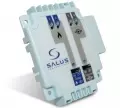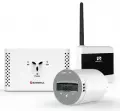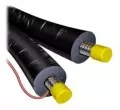APC
For nearly forty years, APC has been the industry standard for reliable electrical power and physical IT infrastructure. Today, he is a leading name in IT departments, large and small, and among our vast community of channel partners. Our history of innovation has moved our products into global awareness with solutions for data infrastructure, management and security that protect organizations around the world.
APC was founded in 1981 as American Power Conversion Corporation with a focus on solar energy research and development. The company was formed by three electrical engineers from MIT, and in 1986 it opened a manufacturing plant in Rhode Island; that same year, the company created its first UPS, the 450AT+, which won an "Editor's Choice" award from PC Magazine. In 1988, APC shares became publicly traded.
1989 saw the introduction of the award-winning PowerChute® software, which revolutionized electrical power management, as well as increased product sales through two major distributors, Tech Data and Ingram Micro. In the 1990s, APC continued to introduce outstanding products such as the Smart-UPS® line, which is now recognized as the industry's leading network protection solution. That same year, President and CEO Rodger B. Dowdell, Jr. awarded as "New England Entrepreneur of the Year" by Inc. magazine. Magazine.
During the 1990s, APC entered other markets with 155 new products, such as SurgeArrest® protective devices, the industry's first modular UPS Matrix-UPS®, the next generation Smart-UPS, the first model Back-UPS Pro® and the Symmetra® Power Array™ , which fundamentally changed the industry by offering redundancy, scalability and service availability in a single solution. These innovations, the opening of two international manufacturing facilities (Galway, Ireland in 1994 and the Philippines in 1996) and the acquisition of Systems Enhancement Corp. and Silcon A/S, enabled APC to exceed $1 billion in annual sales in 1998.
In 1999, APC entered the home technology market with PowerShield, which addresses the growing broadband needs of wired and fixed wireless applications in the home. The company then entered the new millennium with three strategic acquisitions that opened up the DC power market for communications equipment, the cable and connectivity market for home and business IT applications, and the precision cooling market for data centers and communications equipment. After acquiring ARRIS in 2001, APC expanded its broadband power capabilities. In 2002, APC introduced PowerStruXure™, its first Network Critical Physical Equipment (NCPI) architecture that revolutionized data center power management. In the same year, the company was included in the NASDAQ-100 index, a list of the 100 largest non-financial stocks on the market.
In 2003, InfraStruXure™ debuted, integrating power, cooling, racking, control and service into an open, customizable and integrated solution and has won nearly 20 awards worldwide. At the same time, the TravelPower™ travel bag was introduced - the world's first suitcase with built-in device charging capabilities - which was an instant success. The InfraStruXure line was expanded in 2004 to include cooling systems and on-site power generation. In the same year, APC won more than 100 awards worldwide for its products and business excellence. Building on the success of PowerStruXure in 2002, APC expanded its overall NCPI offerings with the acquisition of Netbotz, a pioneering technology company that addressed the physical security of IT equipment, allowing APC to expand its management and security expertise.
On February 14, 2007, APC was purchased by Schneider Electric, a multinational European company known globally for its expertise






















































































































































